Spoken Language
Pupils will be able to:
listen and respond appropriately to adults and their peers, ask relevant questions to extend their understanding and knowledge.
Use relevant strategies to build their vocabulary.
Articulate and justify answers, arguments and opinions.
Give well-structured descriptions, explanations and narratives for different purposes. Maintain attention and participate actively in collaborative conversations, staying on topic and initiating and responding to comments
Use spoken language to develop understanding through speculating, hypothesising, imagining and exploring ideas.
Speak audibly and fluently with an increasing command of Standard English.
Participate in discussions, presentations, performances, role play, improvisations and debates. Gain, maintain and monitor the interest of the listener(s).
Consider and evaluate different viewpoints, attending to and building on the contributions of others.
Select and use appropriate registers for effective communication.
Reading
Pupils will develop:
Excellent phonic knowledge and skills.
Fluency and accuracy in reading across a wide range of contexts throughout the curriculum. Knowledge and understanding of an extensive and rich vocabulary.
An excellent comprehension of texts.
The motivation to read for both study and for pleasure.
Extensive knowledge through having read a rich and varied range of texts.
Writing
Pupils will develop:
The ability to write fluently and with interesting detail on a number of topics throughout the curriculum.
A vivid imagination which makes readers engage with and enjoy their writing.
A highly developed vocabulary and an excellent knowledge of writing techniques to extend details or description.
Well-organised and structured writing, which includes a variety of sentence structures. Excellent transcription skills that ensure their writing is well presented and punctuated, spelled correctly and neat.
A love of writing and an appreciation of its educational, cultural and entertainment values.
Threshold Concepts:
Spoken Language:
Listen, understand and respond
Speak with clarity and accuracy
Conversation skills
Speaking for a range of purposes
Develop vocabulary
Reading
Read words accurately
Understand texts
Writing
Composition
Write with purpose
Use imaginative description
Organise writing appropriately
Use paragraphs
Use sentences appropriately
Analysis and presentation
Analyse writing
Present writing.
Transcription
Present neatly
Spell correctly
Punctuate accurately
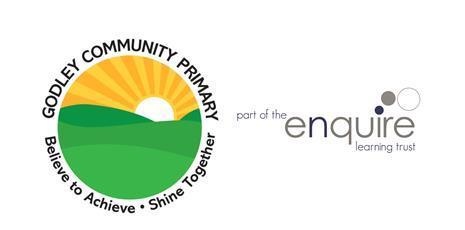

Recpetion
Owl Babies
A New House for Mouse
Handa’s Surprise
Nursery
So Much
First Mother Goose
Reception
Monkey Puzzle
The Gingerbread man
Goldilocks
Nursery
Emergency Margaret Mayo
A Great Big Cuddle
Reception
Emma Jane’s Aeroplane The Everywhere Bear
Nursery
Anna Hibiscus Splash Sharing a Shell
Godley Primary Key Texts Learning Journey
Learn some poems by heart

Year 1
Three Little Pigs
Peace at Last
Jill Murphy
Katie in London
James Mayhew
The Lorax Dr Seuss
How to Stay Alive
Bear Grylls
Journey
Aaron Becker
The Tunnel
Anthony Browne
Myths – The Trojan Horse
The Snail and the Whale
Julia Donaldson
Beegu, Alexis Deacon

2
Hodgeheg
Dick King Smith
Billy and the Beast
Learn a variety of poems by heart
The Minpins
Roald Dahl
Plague – A Cross in the Door
Ann Turnbull

4
Everest Explorers non fiction (Edmund Hillary)
Namaste
Diana Cohn

Lila and the Secret of the Rain
David Conway
Man on the Moon, Simon Bartram
Fantasic Mr Fox
Roald Dahl
Stone Age Boy by Satoshi Kitamura Our Tower
Joseph Coelho
Leon and the Place between Angella Mcallister and Graham Baker-Smith
Red in the city, Marie Voigt
Oliver Twist, by Charles Dickens – Retold by Classic Starts

3
Learn a variety of poems by heart

5
Sky Song, by Abi Elphinstone
Holes, Louis Sachar
Maze Runner, by James Dashner
The Great Kapok Tree, by Lynne Cherry
Running on the Roof of the World
Jess Butterworth]
Viking Boy by Tony Bradman

6
Rooftoppers- by Katherine Rundell
Treason by Berlie Doherty
Storm Breaker by Anthony Harowitz
Goodnight Mr TomMichelle Magorian
Pandora/Shackleton's Journey by William Grill
Playscripts

7
EYFS
Year
Year
Year
Year
Year
Year
Spoken Language
National Curriculum
The national curriculum for English reflects the importance of spoken language in pupils’ development across the whole curriculum – cognitively, socially and linguistically. Spoken language underpins the development of reading and writing.
The quality and variety of language that pupils hear and speak are vital for developing their vocabulary and grammar and their understanding for reading and writing.
Teachers should therefore ensure the continual development of pupils’ confidence and competence in spoken language and listening skills. Pupils should develop a capacity to explain their understanding of books and other reading, and to prepare their ideas before they write.
They must be assisted in making their thinking clear to themselves as well as to others and teachers should ensure that pupils build secure foundations by using discussion to probe and remedy their English misconceptions.
Pupils should also be taught to understand and use the conventions for discussion and debate.
All pupils should be enabled to participate in and gain knowledge, skills and understanding associated with the artistic practice of drama.
Pupils should be able to adopt, create and sustain a range of roles, responding appropriately to others in role.
They should have opportunities to improvise, devise and script drama for one another and a range of audiences, as well as to rehearse, refine, share and respond thoughtfully to drama and theatre performances.
Statutory requirements which underpin all aspects of spoken language across the six years of primary education form part of the national curriculum. These are reflected and contextualised within the reading and writing domains.
Approach to Spoken language


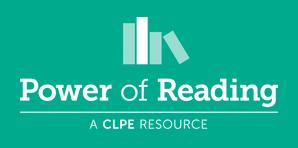
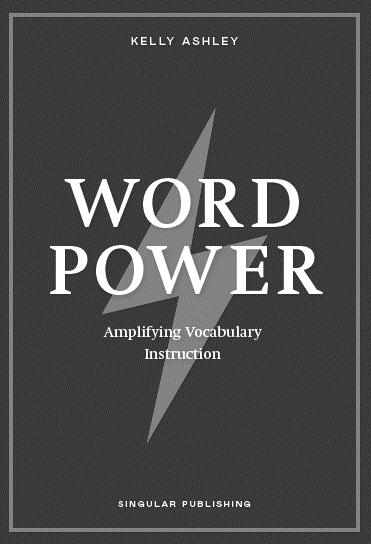
Writing
Writing Construct
High quality text
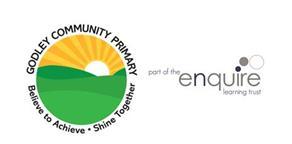
Stimulus/purpose
POR – text reveal, choral reading, tell me, responses to illustrations, predictions, visualization
Timeline/structure
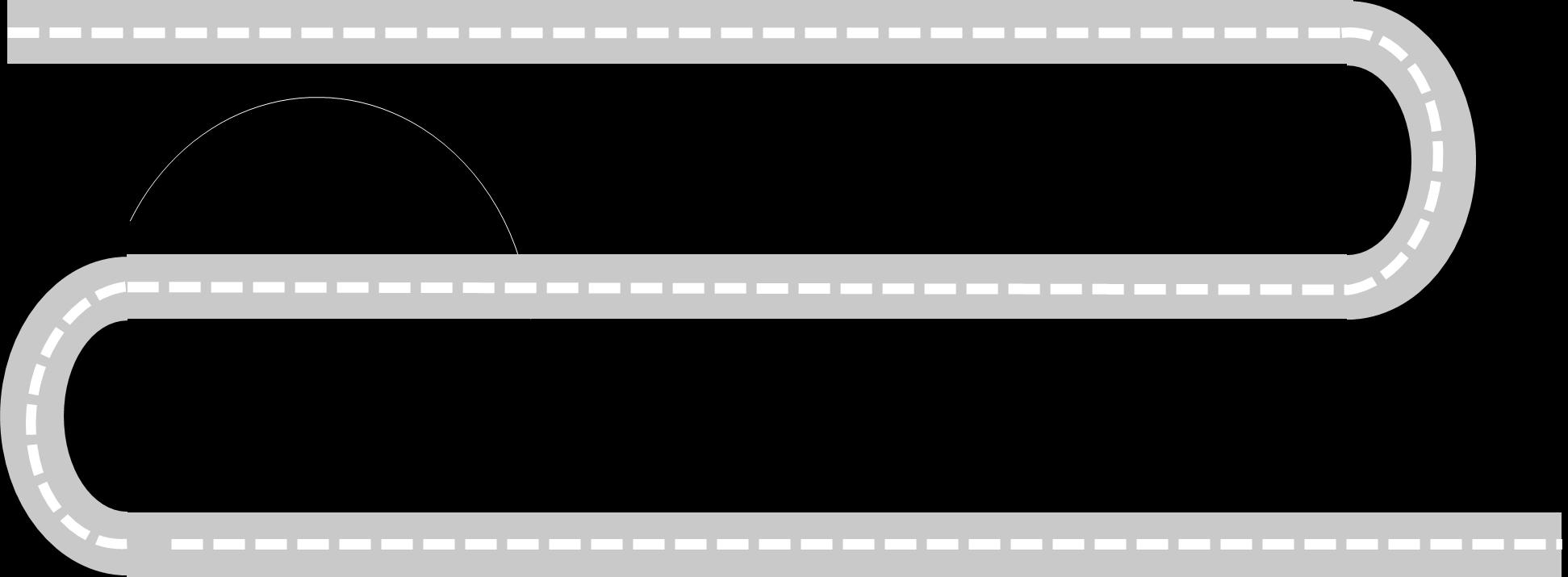
Text Interrogation Planning
Skills Burst
Role-play, role on the wall, conscience alley, hot seating, story mapping, incidental writing

Drafting

Proof read, edit, re- draft
Reading to self, reading aloud, reading to an audience
Apply
Celebrate
Godley Primary Writing Construct Journey
.
Focus reading sessions
Writing Context and Purpose

Reception labels
instructions
captions
Nursery
Talk for writing/mark making Labels, Recount
Reception Letter
narrative – traditional tales
Fact file
Nursery
Talk for writing/mark making
Story mapping
Poetry – rhyming words
Reception instructions
Recount
Nursery
Talk for Writing/mark making fact file labels/ captions
Godley Primary Writing Genres Learning Journey


Narrative - Traditional tales Narrative - Dilemma
Narrative - adventure Narrative – fantasy
Narrative - dilemma Narrative – adventure
Narrative – Dilemma Narrative – Adventure
Diary about Everest
Narrative – story from another culture (Nepal)
Narrative – Sci Fi narrative – folktale
Non-fiction –labelling - house and area (Geography) Recount of Field Trip.
Non-fiction –information text about the UK
Year 1 Year 2
Non-fiction - facts about why the fire spread so quickly (pre curser to explanation text)
Non-fiction –facts about Queen Elizabeth (non chron report)
Non fiction ––explanation text
- How to survive…
Narrative – Fantasy
Non-fiction - InstructionsHow make a working volcano.(Geography)
Non-fiction - Newspaper Report – Romans
Narrative – Myths/Legends
Narrative – Fables
Non-fiction – Non chron report – (Geography)
Non-fiction –Recount going into baas an ancient Greek soldier– (History)
Non-fiction – nonchronological report – the world
Non-fiction - Recount of the World Cup 1666

Non-fiction – balanced argument – Hyde or Salford (Geography)
Non-fiction - non-chron report Alan Turing (History)
Non-fiction -information Text - travel guides (Geography)
Non-fiction – instructionsHow to climb Everest (History)
Non-fiction – Non chronological report (Geography)
Non-fiction - recount – man on the moon (History)
Narrative - Fantasy
Narrative – Adventure

Narrative – Sci Fi
Narrative – story from another culture
Narrative – Fantasy
Narrative – Historical
Non-fiction – Balanced Argument (Geography)
Non-fiction – Explanation text (History)

Year 4
Narrative - adventure/humour
Narrative - Historical
Non-fiction - Persuasive advert – for a settlement (Geography)
Non-fiction – Explanation text (History)
Narrative – AdventureNarrative: Fantasy
Non-fiction – Instructions –how to use a map (Geography)
Non-fiction – explanation text about importance of the Nile (History)
Narrative – Dilemma
Narrative - Historical
Non-fiction - Non- chron report about the UK (Geography)
Non-fiction - Recount/Diary entry (History – Victorians)

Year 3
Narrative - Adventure Fiction
Narrative - Historical
Narrative – Adventure
Narrative – Historical
Narrative – Mystery Narrative – Historical
Narrative – letter Narrative – Play script
Non-fiction – Non Chron Report (Geography)
Non-fiction - Explanation Text (History)
Non-fiction –’how to’ manuals - instructional text (Geography)
Non-fiction – Non Chron Report (History)
Non-fiction – Letter to Council about food waste (Geography)
Year 5 Year 6
Non-fiction – Biography –Alfred the Great (History)

Non-fiction – Balanced Argument (Geography)
Non-fiction – Newspaper Report (History)
Non-fiction – Explanation Text (Geography)
Non-fiction - Diary (History)
Non-fiction – Non-chron report
Non-fiction – persuasive text

7
EYFS
Year
Spelling, grammar and punctuation

Grammar
Words and simple sentences
Captions labels
Punctuation
Capital letters, full stops
Grammar
Words and simple sentences
Captions labels
Punctuation
Capital letters, full stops
Write recognisable letters, most of which are correctly formed; Spell words by identifying sounds in them and representing the sounds with a letter or letters; Write simple phrases and sentences that can be read by others.
Godley Primary SPAG Learning Journey

Learn some poems by heart

Year 1
Grammar
Finger Spaces
Noun phrases
Write a simple sentence.
Past tense
Present tense
Punctuation
Capital letters, full stops
Grammar
Noun phrases
Nouns and verbs
Coordinating conj ‘and’
Sequence sentences
Past/present consistent
Plural noun suffix - s, - es
Punctuation ?!
Capital letters for names, places, days, I
Grammar
Expanded noun phrases
Subordinating conj - because Sequence sentences
Suffix to verbs where no change needed - -ed – er – ing Punctuation ?!
Capital letters for names, places, days, I

Grammar Expanded noun phrases
Coordinating conj - BOA
Subordinating conj – because
Past simple
Grammar
To use standard English forms of verb inflections
Punctuation
‘ for plural possession
Grammar
Adverbials (TRMP)
Choosing nouns/pronouns for clarity
Punctuation
Commas in a list

Grammar
Relative clauses and relative
pronouns
Punctuation
Grammar
Modal verbs
link paragraphs together using tension choices
Grammar Fronted adverbials Subord. Conj. AWHITEBUS
Punctuation
Grammar
Nouns, verbs, adjectives, adverbs
Adverbs
Grammar
Apply all taught - use different sentence structures –e.g. where to put the conjunction, sentence openers.
Past progressive Command, statement, question, exclamation Punctuation Aa . ? !
Learn a variety of poems by heart
Commas after fronted adverbs ‘ for omission

Year 4
Grammar Fronted Adverbials Paragraphs
Sub conjunctions – When, if, that
Present simple
Present progressive
Punctuation
“…” beginning to show , in a list, ‘ omission
Grammar
Subord. Conj. AWHITEBUS
Complex sentences
Present perfect ‘have eaten
Past perfect ‘had eaten’ Prepositions
Punctuation
Beginning to use ‘ for omission
Learn a variety of poems by heart
Grammar use commas to clarify meaning or avoid ambiguity
2 Year 5
Punctuation
Commas for clarity
Parenthesis (dashes, brackets and commas)
Using adverbials for time across paragraphs Punctuation
Hyphens
Colon to introduce a list

6
Grammar
Using adverbials for time across paragraphs
Subjunctive form
Punctuation
Commas for clarity
Passive verbs/voice
Adding detail- dashes and colons
Adding detail- Semi-colons
Punctuation
“…” beginning to show , in a list,
Punctuation “….?” inverted commas with other punctuation ‘ possession
Grammar
Expanded noun phrase Compound sentences
Coordinating conj – FANBOYS
Punctuation “….?” inverted commas with other punctuation

3
Grammar
Modal verb
Punctuation
Parenthesis (dashes, brackets and commas)
Hyphens
Bullet points to list information
Recap all

7
EYFS
Year
Year
Year
Year
Grammar and Punctuation Progressions Year 1
Grammar
Year 1
Nouns
Adjectives
Verbs
Write a simple sentence
Past tense
Present tense
Grammar
Noun phrase
Proper nouns
Coordinating conjunction ‘and’
Compound sentence
Sequence sentences
Plural noun suffix -s, -es
Grammar
Expanded noun phrase
Subordinating conjunction - because
Consistent use of past/present
Suffix to verbs where no change is needed to the spelling -ed, -er, -ing
Punctuation
Finger spaces
Capital Letters
Full stops
Punctuation
Question mark
Exclamation mark
Capital letters for names, places, days and first person I
Punctuation
Capital letters for proper nouns
Applying punctuation taught in Autumn and Spring term
Spring
Autumn Term
Term Summer term
Grammar and Punctuation Progressions Year 2
Autumn Spring Summer
Grammar
Year 2
Expanded noun phrase beginning use of a comma to separate adjectives
Coordinating conjunctions – and, but, so
Subordinating conjunctions- because, until Past simple Past progressive
Command
Statement
Question
Exclamation
Punctuation
Consistent application of punctuation taught in Year 1
Comma (noun phrases)
Grammar
Adverbs for how Adverbs for time
Subordinating conjunctions- when, if Present simple
Present progressive
Synonyms
Contractions
Grammar
Use different sentence structures e.g where to put the conjunction, varying sentence openers.
Prefixes
Suffixes
Third person pronouns
Punctuation
“ “ Beginning to use Apostrophes for omission
Beginning to use bullet points
Punctuation
Commas within a list
Apostrophes for possession
Grammar and Punctuation Progressions Year 3
Grammar
Year 3
Expanded noun phrase using a comma to separate adjectives
Coordinating conjunctions
For, and, but, or, yet so
Grammar
Subordinating conjunctions -although, however, after Subordinate clause Complex sentences
Determiners
Grammar
Fronted adverbials
Paragraphs
Present perfect ‘have eaten’
Past perfect ‘had eaten’ Prepositions
Punctuation
Use of speech marks with other punctuation
Punctuation
Capital letters for proper nouns
Punctuation
Commas within a list
Autumn Spring Summer
Grammar and Punctuation Progressions Year 4
Grammar
Year 4
Fronted adverbials (with a comma)
Subordinating conjunctions – even though,,
Grammar
Choosing nouns/pronouns for clarity and cohesion
Adverbs for time and manner
Grammar
Adverbs for place and reason
To use standard English forms of verb inflections
Punctuation
Comma after a fronted adverb
Commas to mark subordinate clauses
Punctuation
Apostrophes for plural nouns
Punctuation
Ellipses
Spring Summer
Autumn
Grammar and Punctuation Progressions Year 5
Year 5
Grammar
Relative clauses
Relative pronouns
Who, which where, why, whose, that
Grammar
Indicate degrees of possibility using adverbs
perhaps, surely
Modal verbs
Punctuation
Commas to clarify meaning and avoid ambiguity
Might, should, will, must, could, may, would, can
Grammar
Time adverbs to build cohesion across paragraphs
Create complex sentences using ‘ing/ed’ opening clauses
Simile sentence starters
Punctuation
Parenthesis (brackets, dashes and commas)
Punctuation
Hyphens
Commas to introduce a list
Autumn Spring Summer
Grammar and Punctuation Progressions Year
6
Grammar
Synonyms and antonyms
Year 6
Subjunctive voice
Grammar
Passive and active voice
Past and present progressive and past and present perfect tense
Grammar
Application of all taught to independent writing pieces
Punctuation
Hyphens to avoid ambiguity
Adding detail dashes
Punctuation
Use of a semicolon, colon and dash to mark the boundary between independent clauses
Punctuation
Spag revision
Bullet points to list information
Colon to introduce a list and use of semicolons within lists
Autumn Spring Summer
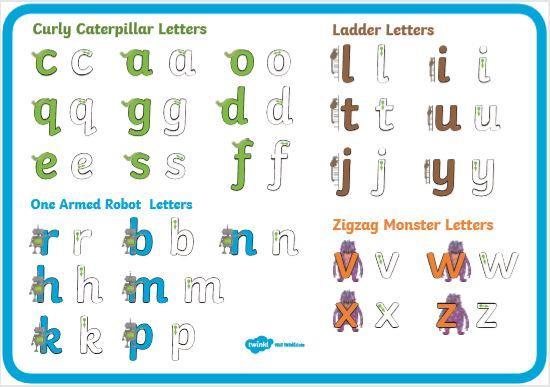
Handwriting
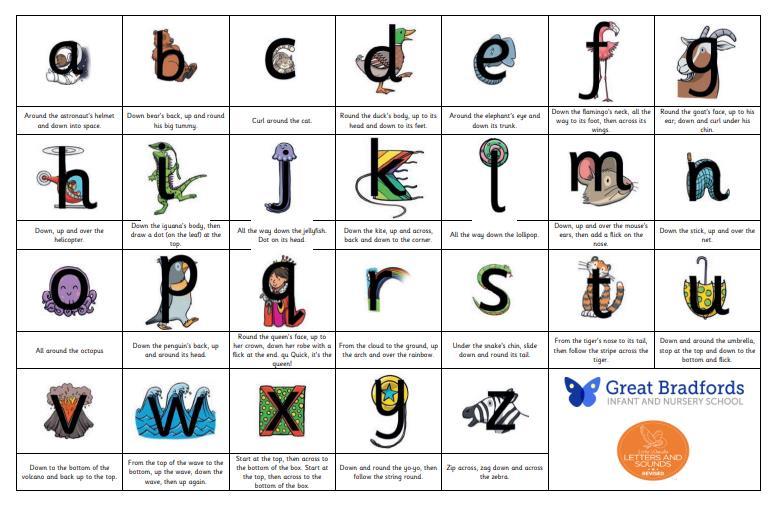

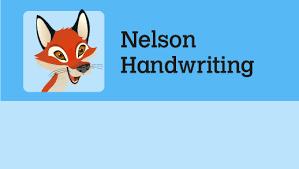






Handwriting Progression – KS1
Handwriting in Year 1 (age
5–6)
In Year 1, your child will learn to: sit correctly and use the right pencil grip form lowercase letters in the correct way: starting in the right place, moving the pencil in the correct direction and finishing in the right place form capital letters in the correct way forming the digits 0–9 understand which letters are formed in similar ways to leave a space between words.
Handwriting in Year 2 (age
6–7)
In Year 2, your child will learn to: form lowercase letters of the correct size relative to one another start using some of the diagonal and horizontal strokes needed to join letters understand which letters, when next to one another, are best left unjoined write capital letters and digits in a size that matches the size of any lowercase letters understand which letters are formed in similar ways use the correct spacing between words.
Handwriting Progression – Lower kS2
In Year 3, your child will start developing fluent handwriting skills, making their writing more consistent and easier to read. They will practise: writing neatly and legibly with letters that are all a similar size joining some letters deciding which letters to join and which letters not to join keeping their writing lines horizontal and keeping the space between lines parallel and consistent keeping the downstrokes of their writing upright and parallel making sure that descenders of one line do not touch the ascenders of the line below.
n Year 4, your child will continue to work on their fluent handwriting skills, making their writing more consistent and easier to read. They will practise: writing neatly and legibly with letters that are all a similar size joining some letters deciding which letters to join and which letters not to join keeping their writing lines horizontal and keeping the space between lines parallel and consistent keeping the downstrokes of their writing upright and parallel making sure that descenders of one line do not touch the ascenders of the line below.
Handwriting Progression – Upper kS2
In Year 5, your child will develop fluent, joined-up writing. This includes: deciding whether or not to join specific letters keeping letters of a consistent size choosing whether it is best to write with a pen or a pencil.
In Year 6, your child will build on their Year 5 handwriting skills and continue to develop fluent, joined-up writing. This includes: writing neatly and clearly deciding whether or not to join specific letters choosing whether to use a pencil or a pen.
Reading

N. Nursery Rhymes
Jack and Jill
Happy Birthday Maisy
My World, Your World
R. The Mouse Who Ate the Moon/he Mouse Who Recahed the Sky/ The Mouse Who Wasn't Afraid
The Owl Who Was Afraid of the Dark Handa's Hen
N. Choo Choo Clackety Clack Shark in the Park
R. Day Monkey, Night Monkey, The Rainforest Book Monster Phonics Traditional Tales Wide range of Traditional Tales
N Sharing a Shell Down in the Jungle
R. Blown Away/Poles Apart/Lost and Found Monster Phonics Traditional Tales )decoding skills)
Dinosuar Roar/Stomp, Chomp, Big Roars, Here Come the Dinosaurs
Godley Primary Focus Reading texts Learning Journey
Learn some poems by heart

Fairy tales –
3 Billy Goats Gruff Hansel and Gretel
Chicken Licken
Wild by Emily Highes
The Cat in the Hat by Dr Seuss
Poetry – The Owl and the Pussy Cat by Edward Lear
On the Ning Nnag Nong by Spike Milligan
Year 1 Year 2
The Lighthouse Keepers
Lunch by David and Ronda Armitage
The Story Tree by Hugh Lupton

Leaf, by Sandra Dieckmann
Poems to perform, by Julia Donaldson
The Robot and the Bluebird Nothing, Mick Ink pen.
Learn a variety of poems by heart
Storm Whale, Benji Davies

Bringing the rain to Kapati Plain, by Verna Aardema Rapunzel
5

Gregory Cool, Caroline Binch
Flotsam – David Wiesner
Greek Myths, by Jaan Menzies.
The Fire children, Eric Maddern Iron Man, by Ted Hughes
Charlotte’s Web – EB White Floodland – Marcus Sedgwick
Poetry - The Tyger by William Blake
Poetry - Warewolf Club Rules

4
Into the First, by Anthony Bowne
UG - Boy genius of the Stone age
Learn a variety of poems by heart
The Journey - Francesca Sanna
Cosmic – Frank CottrellBoyce

6
Manjhi Moves a Mountain, by Nancy Chumin
Wonder by R.J.Palacio
Hot like Fire and Other Poems, by Valerie Bloom
Milo imagines the World, by Matt de la Pena Tin forest, by Helen Ward and Wayne Anderson
What’s it like to be a bird?, by Tim Birkhead

3
Anne Frank, by Josephine Poole Hidden Hope Leavers Playscript
The Sister Who Ate Her Brothers: And Other Gruesome Tales

EYFS
Year
Year
Year
Year
Year
7
Early Reading Phonics Progressions

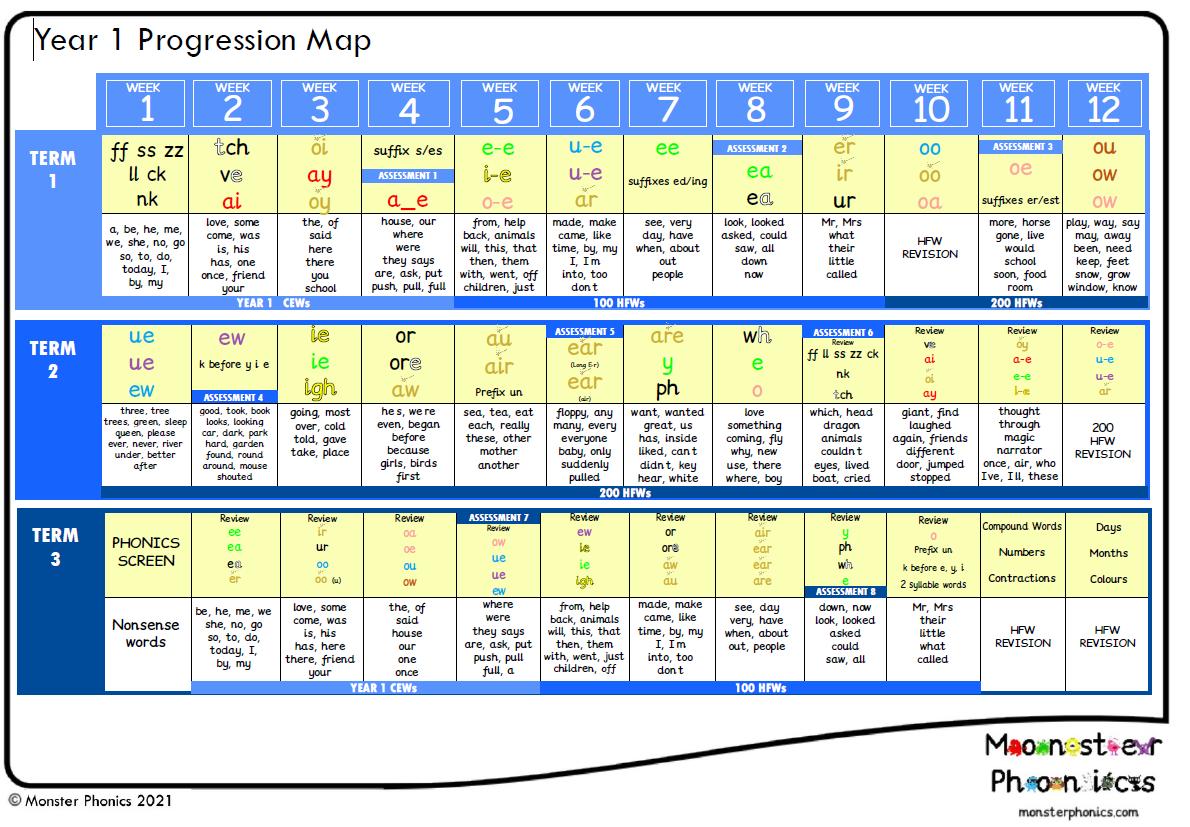

Fluency and Comprehension
Reading Fluency Structure
Delivery:
1. Class Teacher reads text aloud and pupils listen.
2. Whole class discuss tricky vocab and give a summary of the text.
3. Class Teacher reads text again and pupils follow with their eyes on the text using a ruler or finger.
4. In mixed attainment pairs children take turns to read 3-4 times each and partner follows with ruler. Teacher supports where necessary.
5. Text is performed by whole class, volunteers or selected children- try to sound like modelled read.
6. Text is discussed and comprehension checked/deepened
Planning:
Choose an age-appropriate text that takes approximately minute to read.
Select vocabulary that children may need support with – have explanations and pictures ready.
Plan discussion points and question prompts
Use Echo reading to support children where necessary.
Godley Reading Vipers Progressions
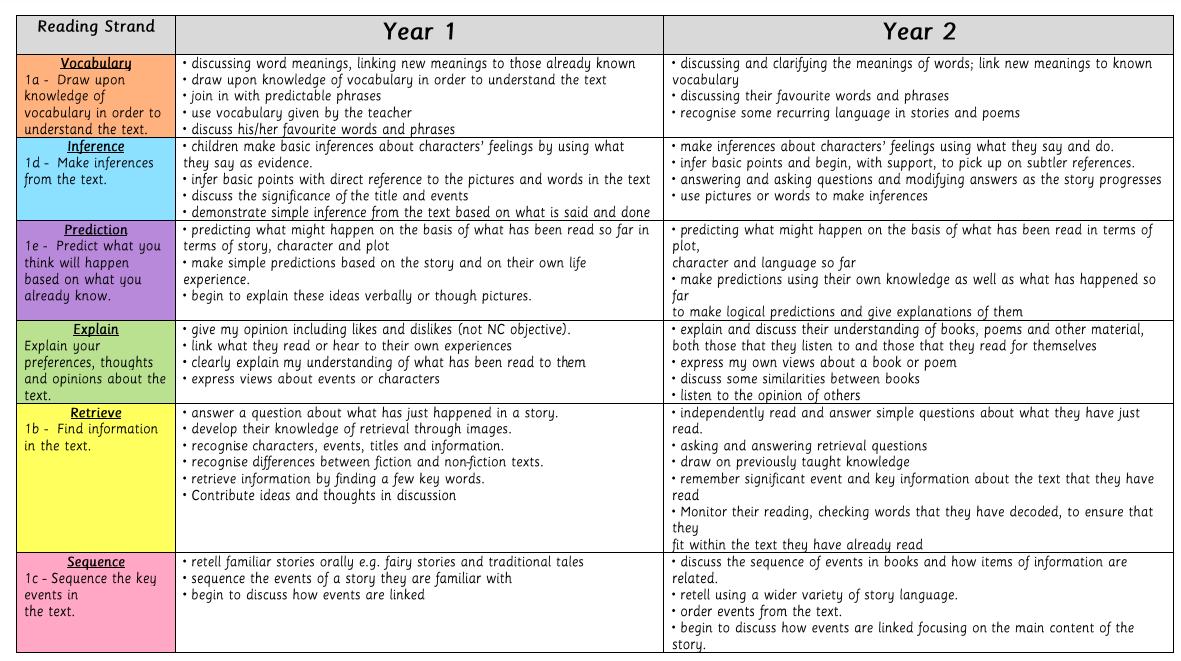
Godley Reading Vipers Progressions
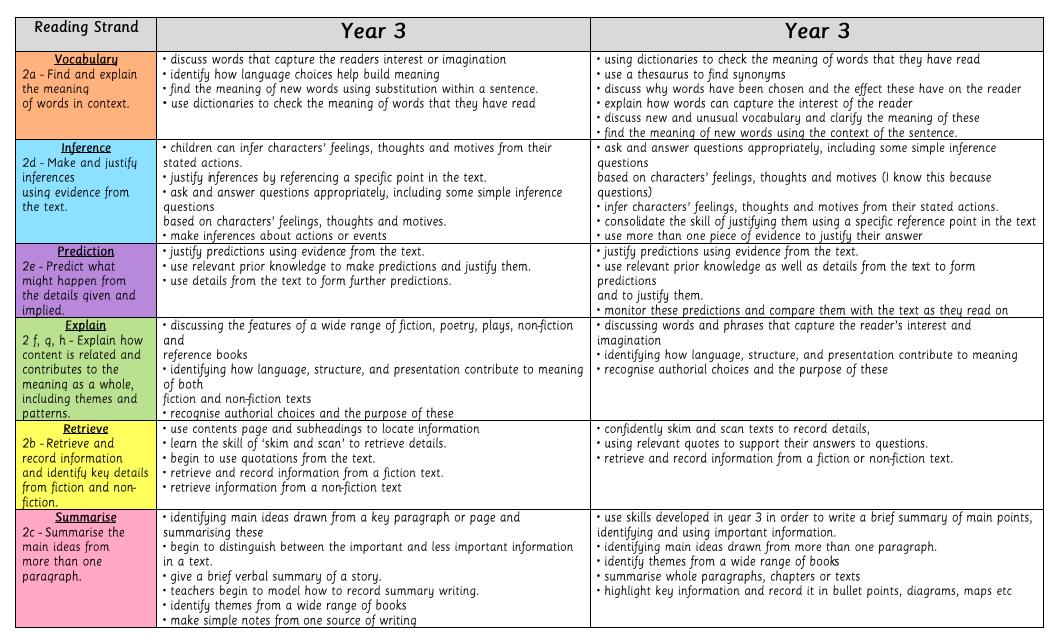
Year 3
Year 4
Godley Reading Vipers Progressions
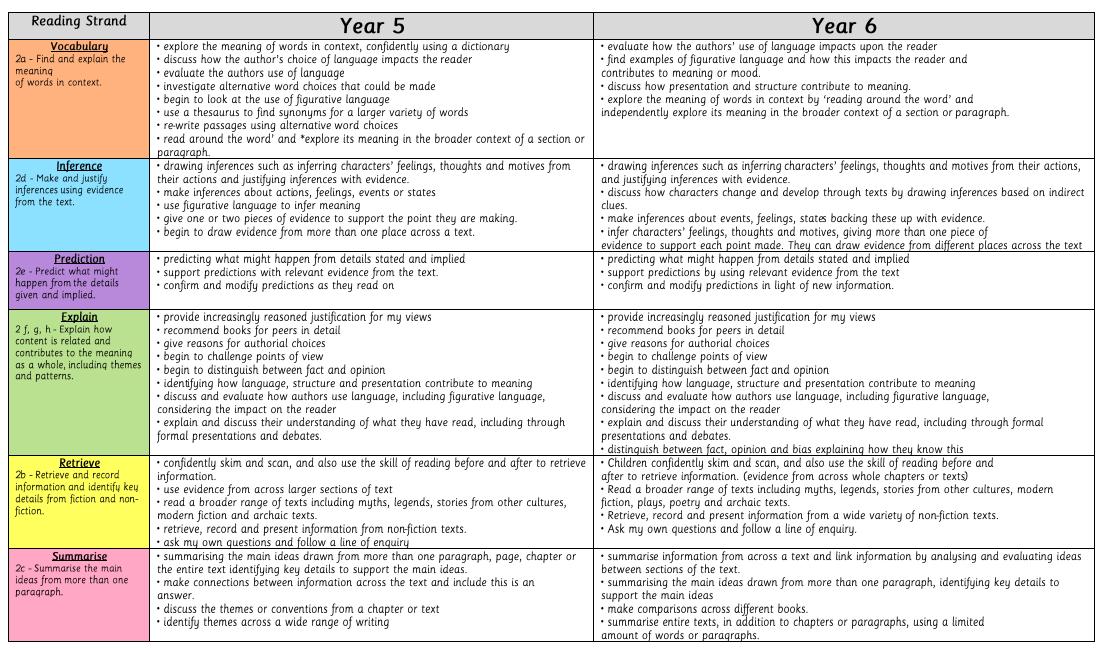
Godley Reading Spines
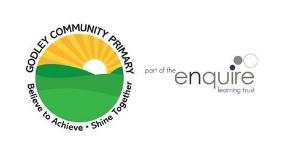
Godley Reading Progressions:
End of Reception – Monster Phonics stage 3 (Supplemented with EY Reading Spine)
End of Year 1 – Monster phonics stage 8 (supplemented with Red Reading Spine)
Year 2 – Orange Reading Spine
Year 3 – Yellow Reading Spine
Year 4 – Green Reading Spine
Year 5 – Blue Reading Spine
Year 6 –Purple Reading Spine
Reading Challenge?
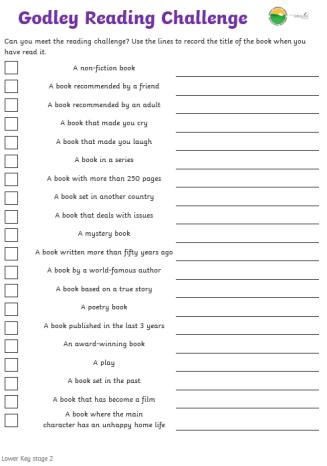

Godley Must Reads
Books that adults should share with their class throughout their time in that year group.
EYFS Nursery
The Gruffalo
We’re going on a Bear
Hunt Brown Bear, Brown Bear
Stickman
The Hungry Caterpillar
Each Peach Pear Plum
Elmer Abigail Reception
Poems out Loud
The Smeds and the Smoos
Jabari Jumps
The Ugly 5
Erol’s Garden
How to Catch a Star
Once upon a Jungle
Rainbow Fish
Owl Babies
Year 1
Poems Aloud
The Story Tree On Sudden Hill
The Jolly Postman
Where the Wild things are Wild Stuck
Stanley’s Stick
Little Red
“Slowly Slowly Slowly,” said the Sloth
Year 2
Poems to Perform – Julia Donaldson
Proudest Blue The Day the Crayons Quit The Secret Sky Garden
Pattan’s Pumpkin The Dark Mr Majeika
The Owl who was Afraid of the Dark Not Now Bernard
Year 3
Please Mrs Butler (Poetry)
The Twits Aesops’ Fables
Milo Imagines the World Look Up
Voices in the Park
Tin Forest
Year 4
Jelly Boots Smelly Boots (Poetry)
Leo and Gorgon’s Curse Into the Forest
George’s Marvellous Medicine
Gregory Cool Flotsam
One Little Bag
Year 5
Heard it in the Playground (poetry)
Pax
The Boy at the back of the Class Clockwork – Phillip Pullman
The Journey
The Invisible
Year 6
Poems the Wind Blew In (Poetry)
The Lion the Witch and the Wardrobe Skellig
The Borrowers Varmints
Watercress
Non-Fiction Books – to be linked to theme or current affairs or interests. Non-Fiction books should be available in the class reading are and shared often with Children.
Comics, Magazines and Newspapers should also be available for children to read in their classroom

Statement of Delivery
English lessons are taught daily
Phonics taught daily in Year R and Year 1. In Year 2 - 3x per week (extra intervention for anyone who did not pass PSC)
Handwriting
Handwriting/fine motor skills – taught daily in EYFS (Squiggle While You Wiggle – Nursery and first half term of Reception, Dough Disco and Little Wandle letter patter.
Handwriting KS1(Nelson/little Wandle ) – Discrete sessions taught weekly and embedded in phonics when introducing a new sound (Cursive)
Handwriting KS2 (Nelson/little wandle)– Starter tasks and intervention.
Reading
1 x whole class reading session per week - focus on POW using high quality texts
Reception and Year 1 - Reading 1:1 or small group (2x per week)
Year 2 – 1x 1:1 or guided read per week and 2x for Lowest 20%
Lower KS2 – 1x 1:1 or guided read per week and 2x for Lowest 20%
Upper KS2 – 2x 1:1 for Lowest 20%
Regular story time in class – focus on MUST reads
Reading incorporated into English sessions through text interrogation.
Reading for pleasure also timetabled across KS2.
Writing
Writing is incorporated into most English sessions.
In skills and drills books children will write to practise SPAG skills and respond to comprehension questions or complete an incidental piece of writing.
In Writing books children will plan their writing, draft their pieces and redraft to improve their work after proof reading and editing. Writing a narrative will build up over a 4-5 week period following the writing construct. Writing a non-narrative will be taught over a 2week unit of work.
An independent piece of sustained writing (Cold Write) will take place at least once per ½ term and can be linked to any theme.
Non-fiction writing is usually linked to the theme but is taught in discrete English sessions.

Scheme of Work:
Spelling
• EY – Monster Phonics
• KS1 – Monster Phonics Spelling groups for testing, spelling rules set out in English Curriculum appendix 1
• KS2 – Twinkl spelling groups for testing, spelling rules set out in English Curriculum appendix 1 English Appendix 1
Handwriting
• EY – Squiggle while you wiggle and Dough Disco used everyday in Nursery and 3x per week in Reception (First Term) Whole class handwriting sessions taught discretely when introducing a letter/sound and discrete handwriting sessions using Nelson Workbook. Little Wandle letter patter and visual aids
• KS1 - Whole class handwriting sessions taught discretely when introducing a letter/sound and discrete handwriting sessions using Nelson Workbook. Use of Little Wandle patter. ½ termly application of handwriting in books assessment (dictation). Little Wandle letter patter and visual aids
• KS2 – Whole class discrete sessions where there is a need. Interventions for identified children which follow the Nelson handwriting scheme.
Grammar
• EY – EY Curriculum expectations
• KS1/KS2 – Skills burst in writing sessions following curriculum expectations set out in appendix 2 Appendix 2
• Word Power - daily


Stimulus
Purpose
POR strategies

Timeline
Structure
Planning

Text Interrogation


✓ Spelling
✓ Grammar
✓ Punctuation
✓ Vocabulary

Stimulus Predictions
Response

Read aloud Discuss POR strategies VIPERS


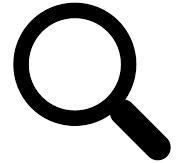
Read accurately – Understand texts
Composition – Analysis and Presentation - Transcription
Skills Burst
Write Proof Read Edit Redraft Share Celebrate Fulfil purpose
Respond Review
Godley Primary – Approach to teaching - English






































